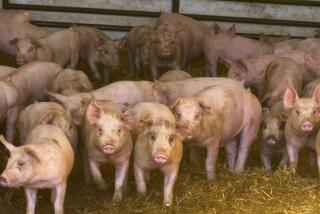High Court Clears Way for Diner to Sue Over Tooth Broken on Food
- Share via
SAN FRANCISCO — One day in March, 1986, Patrice F. Evart stopped by a Granada Hills restaurant for lunch and soon was biting into a juicy hamburger sandwich.
Crack! Evart broke her tooth on what seemed to be a fragment of bone, which she subsequently swallowed. On Thursday, the state Supreme Court, leaving intact a ruling by an appeals court, unanimously allowed the woman to bring an unusual lawsuit against the burger maker for her misfortune.
The high court, in a brief order, refused to review an appeal by food processors from throughout the nation who argued that suits should not be permitted over injuries from a natural element of a product--and that permitting Evart to go to trial would result in a wave of costly litigation over alleged injuries from food substances.
The processors told the court that consumers should reasonably expect that they may sometime find a bone in their burger, a nutshell in their danish, a cherry pit in their pie or a hard, unpopped kernel in their popcorn. Such inevitable occurrences do not make their products defective, they said.
The case posed a novel legal issue. Consumers have long been able to sue for damages from metal, glass or other “foreign” objects they find in their food. But under a 1936 state high court ruling they have generally been prevented from suing for harm from a bone, pit or other “natural” component when it is “common knowledge” that such a substance might turn up in the food.
Over the years, the 1936 decision has been cited widely in similar cases in other states. However, in 1984 a Louisiana court did find that although a pearl in an oyster may be “natural,” it could not have been reasonably anticipated by the diner who bit down on one.
Shortly after she broke her tooth, Evart filed a complaint against the manufacturers, distributors, suppliers and sellers of the hamburger that she said caused her injury.
A year later, a Los Angeles Superior Court judge granted the defendants a summary dismissal of the case after they argued that a bone was a “natural” substance in their product that a customer could well be expected to find.
But on June 15, a state Court of Appeal disagreed, ruling that while the bone was a natural component of the product, Evart still could try to convince a jury that it was not reasonable to anticipate and protect against injury from the bone.
“We are not prepared to state that it is a matter of common knowledge that hamburgers contain pieces of beef bone large enough to cause injury to a consumer,” Appellate Justice Roger W. Boren wrote for a unanimous panel. “We are not requiring that the (defendants’) hamburgers be perfect, only that they be fit for their intended purpose.”
Unlike a chunk of chicken or a steak, a hamburger is intended to be “eaten out of hand,” and consumers could not be seriously expected to use a knife and fork to inspect it for potentially harmful bone fragments, Boren said.
The defendants, backed by the 600-member National Food Processors Assn., appealed the ruling to the high court, saying that unless overturned it could pave the way for a “tremendous and unwarranted” increase in litigation over injury from cherry pits, nutshells and the like. The result, they said, would be an “astronomical” jump in the cost of food.
The high court’s refusal to hear the defendants’ appeal makes the appellate court ruling binding on trial courts throughout the state.
More to Read
Eat your way across L.A.
Get our weekly Tasting Notes newsletter for reviews, news and more.
You may occasionally receive promotional content from the Los Angeles Times.










